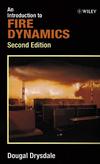Millions of years ago in East Greenland, warming climate and high levels of CO2 in the atmosphere caused plants to evolve from having thick to narrow leaves, which helped prevent them from losing water. Laboratory experiments (in the BRE Centre for Fire Safety Engineering) have shown plants of this shape to be more flammable, and therefore prone to wildfires. The study sheds light on how climate-driven changes in vegetation can cause increases in the flammability of plants. This research may help understanding of whether or not plant life could become more flammable based on global warming estimates.
The work, "in a truly innovative test of their hypothesis, used a Fire Propagation Apparatus calorimeter to test the flammability of modern plant analogues to the Triassic and Jurassic vegetation"
A plant sample of Monkey puzzle being tested for fire behaviour in the Flame Propagation Apparatus calorimeter
The joint research between Fire engineers at the University of Edinburgh and Earth scientists at University College Dublin, the University of Oxford and the Field Museum of Natural History in Chicago, was funded by EU Marie Curie and the University of Edinburgh’s BRE Centre for Fire Safety Engineering and published in Nature Geoscience. Their work also made it onto the front cover (see illustration bellow).
Cover of the Nature Geoscience issue of June 2010 showing a scientific illustration of Greenland's vegetation 200 Myr ago.
Dr Claire Belcher, of University College Dublin, said: "We wanted to test a theory that says if atmospheric CO2 doubles, forest fires in North America may increase by 44 per cent. We tested this by studying how ancient plants and fire changed in the past and used modern experiments on living plants – much like those that grew 200 million years ago – to show that under these conditions, plants became more flammable".
Dr Guillermo Rein, co-author of the work, of the University of Edinburgh’s School of Engineering, said:
"This research brought together scientists from very different backgrounds, and doing so has given us insights into ancient wildfires that we might otherwise not have had. This is the first time our cutting-edge flammability technology has been applied to test geoscience hypothesis and highlights how new ideas can be formed when scientists from very different backgrounds meet"..
For more information please contact:
Dr Claire Belcher, belchercm (at) gmail.com and see her website



















